Jodhpur
Mehrangarh Fort
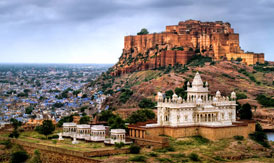 Mehrangarh the Fort of Jodhpur crowns a rocky hill that rises 400 feet above the surrounding plain, and appears both to command and to meld with the landscape. One of the largest forts in Rajasthan, it contains some of the finest palaces and preserves in its museum many priceless relics of Indian courtly life. For over five centuries Mehrangarh has been the headquarters of the senior branch of Rajput clan known as the Rathores. According to their bards, the ruling dynasty of this clan had at an earlier period controlled Kanauj (in what is known as Uttar Pradesh). Like other prominent medieval Rajput rulers – including the famous Prithviraj Chauhan – they were defeated by the invaders from Afghanistan at the end of the 12th century. This catastrophe led to the disruption and migration of the early Rajput clans that they led. The Rathores came to Pali, in Marwar, in what is now central Rajasthan. It is claimed that they were to settle there to protect Brahmin villages against cattle-rustling local tribes.
Mehrangarh the Fort of Jodhpur crowns a rocky hill that rises 400 feet above the surrounding plain, and appears both to command and to meld with the landscape. One of the largest forts in Rajasthan, it contains some of the finest palaces and preserves in its museum many priceless relics of Indian courtly life. For over five centuries Mehrangarh has been the headquarters of the senior branch of Rajput clan known as the Rathores. According to their bards, the ruling dynasty of this clan had at an earlier period controlled Kanauj (in what is known as Uttar Pradesh). Like other prominent medieval Rajput rulers – including the famous Prithviraj Chauhan – they were defeated by the invaders from Afghanistan at the end of the 12th century. This catastrophe led to the disruption and migration of the early Rajput clans that they led. The Rathores came to Pali, in Marwar, in what is now central Rajasthan. It is claimed that they were to settle there to protect Brahmin villages against cattle-rustling local tribes.
Jaswant Thada
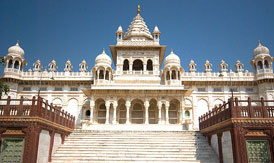 To the left of the Mehrangarh Fort complex is the Jaswant Thada of Jodhpur, Rajasthan. It is a 19th century royal cenotaph built in commemoration of Maharaja Jaswant Singh II, the 33rd Rathore ruler of Jodhpur. The son of Maharaja Jaswant Singh, Maharaja Sardar Singh, in the memory of his father, built the Jaswant Thada. The cenotaph has two more tombs within it. Near to this are the royal crematorium and three other cenotaphs. Famous Jaswant Thada in Jodhpur, India is an example of architectural brilliance in India. It is a white marble memorial, built out of intricately carved sheets of marble. The carving shows the genius of the sculptors. These stones are extremely thin and polished. As a result, the outside surface of the monument emits a warm glow when the sunrays fall on its surface. There is also beautiful marble jali work on the cenotaph. You can have some nice views from the terrace in front of the cenotaph.
To the left of the Mehrangarh Fort complex is the Jaswant Thada of Jodhpur, Rajasthan. It is a 19th century royal cenotaph built in commemoration of Maharaja Jaswant Singh II, the 33rd Rathore ruler of Jodhpur. The son of Maharaja Jaswant Singh, Maharaja Sardar Singh, in the memory of his father, built the Jaswant Thada. The cenotaph has two more tombs within it. Near to this are the royal crematorium and three other cenotaphs. Famous Jaswant Thada in Jodhpur, India is an example of architectural brilliance in India. It is a white marble memorial, built out of intricately carved sheets of marble. The carving shows the genius of the sculptors. These stones are extremely thin and polished. As a result, the outside surface of the monument emits a warm glow when the sunrays fall on its surface. There is also beautiful marble jali work on the cenotaph. You can have some nice views from the terrace in front of the cenotaph.
Umaid Bhawan Palace Museum
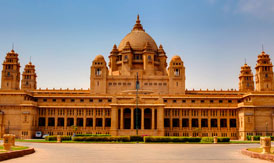 Umaid Bhawan Palace Museum exhibits an exclusive range of items belonging to the Maharajah and the royal family. Located within the Umaid Bhawan Palace, the museum has items ranging from weapons, an array of stuffed leopards, antiques, crockery to various trophies. Exhibits also comprise a huge banner presented by Queen Victoria and a collection of clocks. Within this private museum attached to the palace are displayed arms, furniture, antique clocks and China vases that formed a part of the private collection of the Maharajahs of Jodhpur. Stuffed leopards, and weapons used by the rulers are also displayed in the museum. Tourists can also view a wide collection of crockery, cutlery, rocks, watches, photographs and other antiques in the museum.
Umaid Bhawan Palace Museum exhibits an exclusive range of items belonging to the Maharajah and the royal family. Located within the Umaid Bhawan Palace, the museum has items ranging from weapons, an array of stuffed leopards, antiques, crockery to various trophies. Exhibits also comprise a huge banner presented by Queen Victoria and a collection of clocks. Within this private museum attached to the palace are displayed arms, furniture, antique clocks and China vases that formed a part of the private collection of the Maharajahs of Jodhpur. Stuffed leopards, and weapons used by the rulers are also displayed in the museum. Tourists can also view a wide collection of crockery, cutlery, rocks, watches, photographs and other antiques in the museum.
Zipline & Aerial Adventure Parks
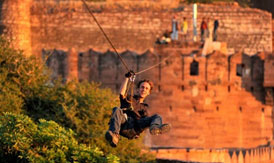 For some truly exhilarating experiences, try Zip Lining with Flying Fox, which generally operates during September to May and start from the Mehrangarh Fort. A 1.5 hour aerial adventure, Flying Fox essentially involves zipping through 6 zip wires, usually 110 to 300 m in length, separated by short walks. Bookings are to be done 3 day before and the going rates are INR 1,200 for adults and INR 1,000 for students (they also offer discounts and special prices). Every interested individual is given a short safety lesson, followed by practice tours, after which the real fun begins. Zoom over the blue city, get a bird's eye view of the Chokelao Garden and Rani Ser Lake. Thrilling, exhilarating, but safe, zip-line tours are a phenomenal hit amongst adventure lovers.
For some truly exhilarating experiences, try Zip Lining with Flying Fox, which generally operates during September to May and start from the Mehrangarh Fort. A 1.5 hour aerial adventure, Flying Fox essentially involves zipping through 6 zip wires, usually 110 to 300 m in length, separated by short walks. Bookings are to be done 3 day before and the going rates are INR 1,200 for adults and INR 1,000 for students (they also offer discounts and special prices). Every interested individual is given a short safety lesson, followed by practice tours, after which the real fun begins. Zoom over the blue city, get a bird's eye view of the Chokelao Garden and Rani Ser Lake. Thrilling, exhilarating, but safe, zip-line tours are a phenomenal hit amongst adventure lovers.
Clock Tower
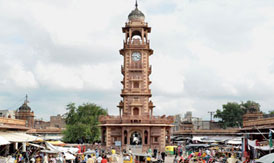 A major landmark of Jodhpur, the area around the Clock Tower or Ghanta Ghar , is a vibrant market place and offers its visitors an exciting shopping experience. You can shop here for the finest variety of spices. Mathaniya's red chili is famous for its dark red colour and is a must buy. Other things to look out for include hand-embroidered fabrics, handicrafts, antiques and flavoured teas. Also, indulge in Makhania lassi (buttermilk), Shahi samosa and omelettes for a true Rajasthani experience. In fact, people would tell you that the lassi at Clock Tower is considered to be the best lassi in the world. The century-old clock tower is an old city landmark surrounded by the vibrant sounds, sights and smells of Sardar Market, which is marked by triple gateways at its northern and southern ends. The narrow, winding lanes of the old city spread out in all directions from here. Westward, you plunge into the old city’s commercial heart, with crowded alleys and bazaars selling vegetables, spices, sweets, silver and handicrafts.
A major landmark of Jodhpur, the area around the Clock Tower or Ghanta Ghar , is a vibrant market place and offers its visitors an exciting shopping experience. You can shop here for the finest variety of spices. Mathaniya's red chili is famous for its dark red colour and is a must buy. Other things to look out for include hand-embroidered fabrics, handicrafts, antiques and flavoured teas. Also, indulge in Makhania lassi (buttermilk), Shahi samosa and omelettes for a true Rajasthani experience. In fact, people would tell you that the lassi at Clock Tower is considered to be the best lassi in the world. The century-old clock tower is an old city landmark surrounded by the vibrant sounds, sights and smells of Sardar Market, which is marked by triple gateways at its northern and southern ends. The narrow, winding lanes of the old city spread out in all directions from here. Westward, you plunge into the old city’s commercial heart, with crowded alleys and bazaars selling vegetables, spices, sweets, silver and handicrafts.
Rao Jodha Desert Rock Park
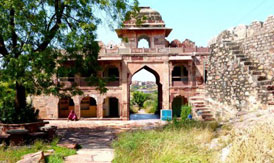 Rao Jodha Desert Rock Park was created in 2006 to try
and restore the natural ecology of a large, rocky wasteland
next to Mehrangarh Fort in Jodhpur. It had suffered years of neglect and was overrun by baavlia (Prosopis juliflora), an invasive, thorny shrub introduced from central America almost a century ago. The challenge was to eradicate the baavlia and create a suitable home for native rock-loving plants that we would bring back from the desert. Baavlia is known to be extremely difficult to eradicate. After trying several different methods without success, we employed Khandwaliya miners to use time-tested ways of manually chiseling into the hard, volcanic rock. We knew we had to go down at least 45 cm below ground-level to kill the baavlia. It was hard going and very slow, but it worked! We decided to plant only where baavlia had shown us that it was possible for a plant to grow in this rocky tract.
Rao Jodha Desert Rock Park was created in 2006 to try
and restore the natural ecology of a large, rocky wasteland
next to Mehrangarh Fort in Jodhpur. It had suffered years of neglect and was overrun by baavlia (Prosopis juliflora), an invasive, thorny shrub introduced from central America almost a century ago. The challenge was to eradicate the baavlia and create a suitable home for native rock-loving plants that we would bring back from the desert. Baavlia is known to be extremely difficult to eradicate. After trying several different methods without success, we employed Khandwaliya miners to use time-tested ways of manually chiseling into the hard, volcanic rock. We knew we had to go down at least 45 cm below ground-level to kill the baavlia. It was hard going and very slow, but it worked! We decided to plant only where baavlia had shown us that it was possible for a plant to grow in this rocky tract.
Mandore Gardens
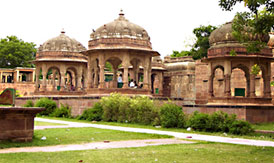 Mandore is located about 5 miles north of Jodhpur. It was the former capital of Maharajas of Marwar. Later it was abandoned for security concerns regarding the Mehrangarh fort. Its extensive Mandore garden, with high rock terrace, makes it a popular local attraction. The garden is open for tourists from 8 am to 8 pm. In the Mandore garden, there are the dewals or cenotaphs of Jodhpur's former rulers. Instead of the usual chhatri-shaped cenotaphs typical of Rajasthan, the cenotaphs of the famous Mandore garden of Jodhpur, Rajasthan are built along the lines of a Hindu temple. They are four stories high, with fine columns and an elegant spire, all in red sandstone. The most impressive dewal is the dewal of Maharaja Ajit Singh. These cenotaphs are set in beautiful landscaped gardens. The cenotaphs of the Maharani are set on a rocky outcrop over the hill.
Mandore is located about 5 miles north of Jodhpur. It was the former capital of Maharajas of Marwar. Later it was abandoned for security concerns regarding the Mehrangarh fort. Its extensive Mandore garden, with high rock terrace, makes it a popular local attraction. The garden is open for tourists from 8 am to 8 pm. In the Mandore garden, there are the dewals or cenotaphs of Jodhpur's former rulers. Instead of the usual chhatri-shaped cenotaphs typical of Rajasthan, the cenotaphs of the famous Mandore garden of Jodhpur, Rajasthan are built along the lines of a Hindu temple. They are four stories high, with fine columns and an elegant spire, all in red sandstone. The most impressive dewal is the dewal of Maharaja Ajit Singh. These cenotaphs are set in beautiful landscaped gardens. The cenotaphs of the Maharani are set on a rocky outcrop over the hill.
Balsamand Lake and Garden
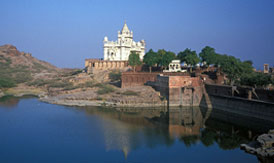 A stone's throw away from the ancient capital of Marwar, Mandore, and only 8 km from the city-center of Jodhpur, Bal Samand is a world away from the hustle and bustle of modern life. The lake was engineered in the 12th Century but the exquisite red sand-stone palace came later; it was built by Maharaja Jaswant Singh I of Jodhpur in the 17th Century, at the very zenith of Rathore Rule under the umbrella of the Mughal Empire. Set in a private estate of over 60 Acres, with sprawling orchards of lime and pomegranate and landscaped gardens criss-crossed by elegant waterways and even a aqueduct, the palace with its lovely promenade on the lake, was always more than just a residence; a pleasure palace in the finest Mughal tradition of the picnic. In more recent times a tradition has developed with the Royal Family celebrating the first rains in Bal Samand; a custom that has led to the palace being referred to as a Monsoon Palace.
A stone's throw away from the ancient capital of Marwar, Mandore, and only 8 km from the city-center of Jodhpur, Bal Samand is a world away from the hustle and bustle of modern life. The lake was engineered in the 12th Century but the exquisite red sand-stone palace came later; it was built by Maharaja Jaswant Singh I of Jodhpur in the 17th Century, at the very zenith of Rathore Rule under the umbrella of the Mughal Empire. Set in a private estate of over 60 Acres, with sprawling orchards of lime and pomegranate and landscaped gardens criss-crossed by elegant waterways and even a aqueduct, the palace with its lovely promenade on the lake, was always more than just a residence; a pleasure palace in the finest Mughal tradition of the picnic. In more recent times a tradition has developed with the Royal Family celebrating the first rains in Bal Samand; a custom that has led to the palace being referred to as a Monsoon Palace.
Bullet Baba Temple
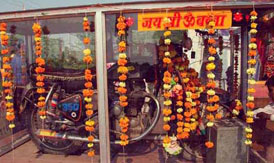 Some 50km from Jodhpur, along National Highway 65, is a temple. Nothing unusual about that. After all, this is India and temples dot the landscape here. But this temple is different. The main deity is a 350cc Royal Enfield Bullet motorcycle. And, while the temple is named Om Banna, it is better known as the Bullet Baba temple. All this calls for an explanation. Over two decades ago, 21-year-old Om Singh Rathore, the son of a local village leader, was on his way home when he met with a fatal accident on the highway. The police hauled away the motorcycle and that’s when the legend began. “The bike was not in the police station the next day. It was found at the accident spot,” says Naresh Bhatti, a local cab driver. The police took the bike back, this time securing it with chains and deflating its tyres. The story goes that the next morning the motorcycle was again found at the accident spot.
Some 50km from Jodhpur, along National Highway 65, is a temple. Nothing unusual about that. After all, this is India and temples dot the landscape here. But this temple is different. The main deity is a 350cc Royal Enfield Bullet motorcycle. And, while the temple is named Om Banna, it is better known as the Bullet Baba temple. All this calls for an explanation. Over two decades ago, 21-year-old Om Singh Rathore, the son of a local village leader, was on his way home when he met with a fatal accident on the highway. The police hauled away the motorcycle and that’s when the legend began. “The bike was not in the police station the next day. It was found at the accident spot,” says Naresh Bhatti, a local cab driver. The police took the bike back, this time securing it with chains and deflating its tyres. The story goes that the next morning the motorcycle was again found at the accident spot.
Phool Mahal
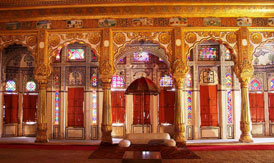 Phool Mahal (Flower Palace) is one of the most opulent and eminent period rooms in the Mehrangarh Fort. Visitors come here to catch a glimpse of the extravagant lifestyle of the erstwhile rulers. Built by Maharaja Abhaya Singh in the 18th century, it served as a pleasure room for female dancers during his reign. This room is beautifully decorated with its ceiling boasting of rich filigree of gold - plundered from Gujarat after the king's triumph over Sarbuland Khan, a Mughal Governor. At present, the room comprises a rare collection of paintings, royal portraits and the famous raga mala paintings. The Phool Mahal in Jodhpur (Flower Palace) remains intact to this date, with its gold filigree ceiling and stained glass windows. Sileh Khana has a collection of the varied weapons including gem-studded shields and armours for war elephants. A visit to this place will take you back in time to the era of Rajputana glory.
Phool Mahal (Flower Palace) is one of the most opulent and eminent period rooms in the Mehrangarh Fort. Visitors come here to catch a glimpse of the extravagant lifestyle of the erstwhile rulers. Built by Maharaja Abhaya Singh in the 18th century, it served as a pleasure room for female dancers during his reign. This room is beautifully decorated with its ceiling boasting of rich filigree of gold - plundered from Gujarat after the king's triumph over Sarbuland Khan, a Mughal Governor. At present, the room comprises a rare collection of paintings, royal portraits and the famous raga mala paintings. The Phool Mahal in Jodhpur (Flower Palace) remains intact to this date, with its gold filigree ceiling and stained glass windows. Sileh Khana has a collection of the varied weapons including gem-studded shields and armours for war elephants. A visit to this place will take you back in time to the era of Rajputana glory.
Ramdevra Temple
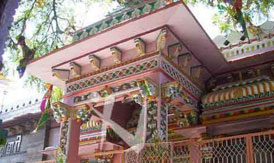 Ramdevra Temple, also known as Shri Ramdev Temple, is an important religious site situated in the namesake village. The temple was built by the mighty king of Bikaner - Maharaja Ganga Singh in 1931 to pay homage to Baba Ramdevji. Legend has it that, he took samadhi here at the age of 33, in the year 1442 and lived his entire life working for the upliftment of the downtrodden. Some regard him as an incarnation of Lord Krishna, while Muslims respect him as Ramshah Pir. People belonging to different castes and religions visit this temple year-round. A fair is organised twice a year at the temple in remembrance of the renowned saint. There is a water tank called Ramsarovar behind the temple, which is considered sacred. It is believed that a dip in the holy water of this tank purifies the soul.
Ramdevra Temple, also known as Shri Ramdev Temple, is an important religious site situated in the namesake village. The temple was built by the mighty king of Bikaner - Maharaja Ganga Singh in 1931 to pay homage to Baba Ramdevji. Legend has it that, he took samadhi here at the age of 33, in the year 1442 and lived his entire life working for the upliftment of the downtrodden. Some regard him as an incarnation of Lord Krishna, while Muslims respect him as Ramshah Pir. People belonging to different castes and religions visit this temple year-round. A fair is organised twice a year at the temple in remembrance of the renowned saint. There is a water tank called Ramsarovar behind the temple, which is considered sacred. It is believed that a dip in the holy water of this tank purifies the soul.